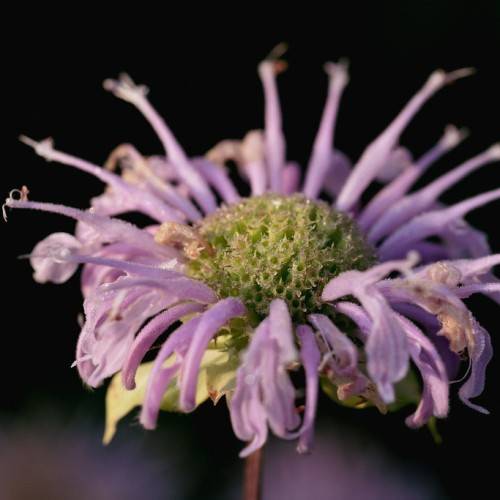
bee balm
Monarda didyma 'Pardon My Lavender'
Cycle:
Herbaceous Perennial
Watering:
Frequent
Hardiness Zone:
4 - 9
Flowers:
Flowers
Sun:
Full sun,part shade
Leaf:
Yes
Growth Rate:
Low
Maintenance:
Moderate
Care Level:
Medium
watering
Bee balm (Monarda didyma 'Pardon My Lavender') needs to be watered consistently. Generally, water the soil when the top inch of soil is dry to the touch and, if possible, give the plant a deep soaking once or twice per week, providing 1-2 inches of water per application. To make sure your can water the entire root system, keep the soil moist but not soggy and avoid overwatering. If the soil is allowed to dry out completely, the leaves may drop. Avoid putting water on the leaves while watering and use lukewarm water to avoid shocking the roots.
sunlight
Bee balm (Monarda didyma 'Pardon My Lavender') should be placed in full sun for at least 6 hours a day. This species does best when it has plenty of sun throughout the day. If the sun exposure is too little, the plants will suffer from lack of growth and will not flower. To ensure ample sun exposure, gardeners should locate this species in an area that receives direct sunlight for most of the day. Avoid areas that have partial shade, as this will not be enough to meet the plant’s needs.
pruning
Bee Balm (Monarda didyma 'Pardon My Lavender') should be pruned after flowering is complete. Cut the flower stalks back to about 4-6 inches above the soil line. Pruning will encourage perennial growth, increased flowering and helps to prevent tall, spindly stalks. Prune again in late summer to early fall, removing up to 1-third of the previous season's growth and any undesirable dead or diseased stems. Make sure to disinfect your pruners before and after each use.
Season
Hardiness Map
FAQ
Is bee balm a native plant?
Yes, bee balm is a native plant. It is a member of the mint family and is native to much of North America. It is easy to grow and is popular in home gardens and butterfly gardens. The plant is often referred to as wild bergamot, horsemint and bee balm and typically blooms in late summer or early fall. Its fragrant flowers are attractive to bees, butterflies, moths and hummingbirds.
Should I plant bee balm in a container or on the ground?
Bee balm is an attractive, fragrant flowering plant that does well in both containers and planted directly in the ground. When planting bee balm in a container, be sure to choose a pot with plenty of drainage holes, and fill it with quality potting soil, or a blend of soil with compost. For best results, plant bee balm in direct sunlight, or in a spot where it will get at least six hours of bright, indirect sunlight. When planting bee balm directly in the ground, be sure to choose a location with well-draining soil and plenty of space for it to spread and thrive. Adding a layer of compost to the soil will increase drainage and help it thrive. No matter where you plant bee balm, be sure to water regularly, and remove spent flowers to encourage more blooms.
Could bee balm be used in a butterfly garden?
Yes, bee balm can absolutely be used in a butterfly garden. This herbaceous mint produces beautiful, vibrant flowers in shades of red, white, and pink that attract a variety of pollinators, including butterflies. In addition to its colorful flowers, bee balm has a strong scent that can be used to entice butterflies even more. To ensure that butterflies visit your butterfly garden, plant bee balm in a sunny location and keep the soil moist.
Is bee balm drought-tolerant?
Yes, bee balm is considered to be very drought-tolerant once established. It can withstand periods of dry weather and does not require frequent watering to survive. It does, however, respond best to wetter conditions, so watering regularly is recommended for optimal health. Bee balm is also suitable for growing in xeriscapes, which are areas with very low water requirements.
Should I deadhead bee balm flowers?
Deadheading bee balm flowers is definitely recommended. This simple process helps to encourage further bloom, as well as preventing the flowers from going to seed. To deadhead, simply use sharp scissors or pruning shears to cut off the stems that have already bloomed. Be careful not to prune too far back, as this could potentially damage the plant in the process. After deadheading, be sure to dispose of the cuttings away from the plant, to prevent the spread of disease.
Is bee balm annual or perennial?
Bee balm, also called Monarda, is an herbaceous perennial plant from the mint family. Bees and other pollinators are attracted to the vibrant colors and aroma of bee balm. The plant is easy to grow, but is usually only grown as a perennial in USDA hardiness zones 4-9. In colder zones, bee balm will die to the ground as winter sets in, but will return in the spring.
Could bee balm be used in herb gardens?
Yes, bee balm can be used in herb gardens. Bee balm is an attractive perennial herb that provides color and fragrant blossoms, which is beneficial to any herb garden. Bee balm also attracts pollinators such as bees and butterflies to the garden. It is easy to grow and care for and can be used in a variety of culinary and medicinal recipes. Bee balm is an ideal ornamental herb to include in any herb garden.
